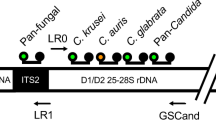Abstract
We present a case of invasive fungal co-infection in a young patient treated for an acute myeloid leukemia and having undergone a twice-haploid matched unrelated donor hematopoietic stem cell transplantation (HSCT) with two different donors. A mucormycosis diagnosis was made shortly after the patient’s admission using imagery and specific Mucorales qPCR which was treated with liposomal amphotericin B and posaconazole. Twenty days later, a blood culture was positive for Fusarium solani, and disseminated cutaneous lesions appeared. The antifungal treatment was changed to liposomal amphotericin B and voriconazole. Thanks to a complete hematological reconstitution and despite a co-infection with two aggressive filamentous opportunistic fungi, the patient recovered. We took advantage of this clinical case to test a specific Fusarium solani qPCR, which proved to be promising when performed retrospectively on some of the patient samples.
This is a preview of subscription content, access via your institution
Access options
Subscribe to this journal
Receive 12 print issues and online access
$259.00 per year
only $21.58 per issue
Buy this article
- Purchase on Springer Link
- Instant access to full article PDF
Prices may be subject to local taxes which are calculated during checkout

Similar content being viewed by others
References
Bellanger AP, Millon L, Berceanu A, Grenouillet F, Grenouillet FE, Larosa F, et al. Combining Aspergillus mitochondrial and ribosomal QPCR, in addition to galactomannan assay, for early diagnosis of invasive aspergillosis in hematology patients. Med Mycol. 2015;53:760–4.
Millon L, Herbrecht R, Grenouillet F, Morio F, Alanio A, Letscher-Bru V. French Mycosis Study Group et al. Early diagnosis and monitoring of mucormycosis by detection of circulating DNA in serum: retrospective analysis of 44 cases collected through the French Surveillance Network of Invasive Fungal Infections (RESSIF). Clin Microbiol Infect. 2016;22:810e1–e8.
Millon L, Scherer E, Rocchi S, Bellanger AP. Molecular strategies to diagnose mucormycosis. J Fungi. 2019;5:24–31.
Kontoyiannis DP, Yang H, Song J, Kelkar SS, Yang X, Azie N, et al. Prevalence, clinical and economic burden of mucormycosis-related hospitalizations in the United States: a retrospective study. BMC Infect Dis. 2016;16:730–6.
Jeong W, Keighley C, Wolfe R, Lee WL, Slavin MA, Kong DCM, et al. The epidemiology and clinical manifestations of mucormycosis: a systematic review and meta-analysis of case reports. Clin Microbiol Infect. 2019;25:26–34.
Nucci F, Nouér SA, Capone D, Anaissie E, Nucci M. Fusariosis. Semin Respir Crit Care Med. 2015;36:706–14.
Yu J, Chen Y, Fang J, Zhang K. Successful treatment of disseminated fusariosis in a patient with acute lymphoblastic leukemia: a case report and literature review. Medicine. 2019;98:16246–52.
Montagna MT, Lovero G, Coretti C, Martinelli D, Delia M, De Giglio O, et al. SIMIFF study: Italian fungal registry of mold infections in hematological and non-hematological patients. Infection. 2014;42:141–51.
Lortholary O, Fernández-Ruiz M, Perfect JR. The current treatment landscape: other fungal diseases (cryptococcosis, fusariosis and mucormycosis). J Antimicrob Chemother. 2016;71:31–6.
Mikulska M, Furfaro E, Del Bono V, Gualandi F, Raiola AM, Molinari MP, et al. Galactomannan testing might be useful for early diagnosis of fusariosis. Diagn Microbiol Infect Dis. 2012;72:367–9.
EPA Technology for mold identification an enumeration. Microbiological and Chemical Exposure assessment. https://irp-cdn.multiscreensite.com/c4e267ab/files/uploaded/gCQnkBNWQuSD96fPIikY_EPA_TechnologyforMoldIdentificationandEnumeration.pdf.
Koehler P, Tacke D, Cornely OA. Bone and joint infections by mucorales, scedosporium, fusarium and even rarer fungi. Crit Rev Microbiol. 2016;42:158–71.
Acknowledgements
We thank Pamela Albert for her editorial assistance. We thank Dr. Olivier Lortholary for his advice on antifungal therapeutic management regarding the MIC result obtained from the National Reference Center (Paris, France).
Author information
Authors and Affiliations
Corresponding author
Ethics declarations
Conflict of interest
The authors declare that they have no conflict of interest.
Additional information
Publisher’s note Springer Nature remains neutral with regard to jurisdictional claims in published maps and institutional affiliations.
Rights and permissions
About this article
Cite this article
Bellanger, AP., Rocchi, S., Berceanu, A. et al. Positive quantitative PCR detecting Fusarium solani in a case of mixed invasive fungal disease due to Mucorales and Fusarium solani. Bone Marrow Transplant 55, 873–876 (2020). https://doi.org/10.1038/s41409-020-0819-3
Received:
Revised:
Accepted:
Published:
Issue Date:
DOI: https://doi.org/10.1038/s41409-020-0819-3


